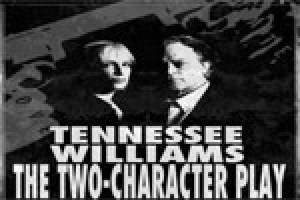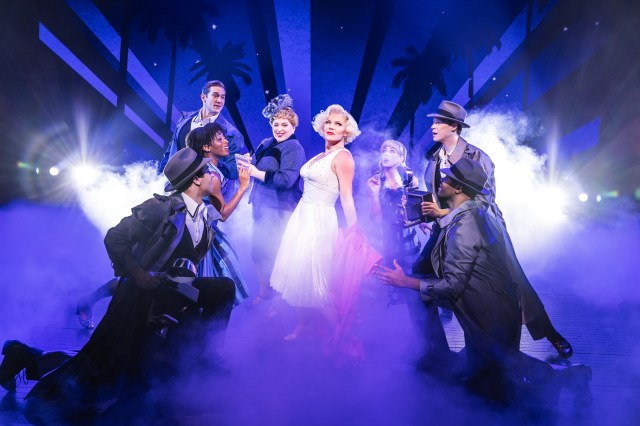Though still relatively obscure, the fourth item, a commercial venture at New World Stages, was probably the best known of the lot, Tennessee Williams’ 1975 The Two-Character Play, a problematic late-Williams opus that also exists in an alternative version called Out Cry. I imagine more New Yorkers have at least heard of it than have encountered all three of the earlier works combined. Though filmed in the early-talkie era, The Silver Cord has been a rarity in revival houses or on commercial video. The Henrietta provoked two silent-film versions, respectively starring Douglas Fairbanks Sr. (The Lamb, 1915) and Buster Keaton (The Saphead, 1921); both diverge widely from the source play’s sardonic text.
The oldest and newest of this quartet turned out to be its prizes. The Henrietta, sharp-edged and funny (and given a lively production by Metropolitan’s artistic director, Alex Roe) came off vividly enough to make you wonder why it hasn’t been seen more often. The Two-Character Play, an eerily personal, hermetic work that I doubt I’ll ever love in any version, was handled so impressively by Amanda Plummer and Brad Dourif, under Gene David Kirk’s direction, that it made the sensation of being locked for two hours inside Williams’ tormented brain at its most nervously echolalic seem worthwhile, perhaps even ennobling. These were object rebukes to our foolish habit of neglecting the past.
The other two, in contrast, proved to be merely curios. Hunter’s quasi-Chekhovian treatments of the waning British upper class, which had a brief London vogue in the 1950s, always seemed too thin-blooded to travel well, and Gus Kaikkonen’s stylish, solidly acted production for the Mint couldn’t cure this one’s anemia, not even with George Morfogen snarking up a deliciously stagy storm as an eccentric elderly uncle. Dan Wackerman, staging The Silver Cord, made an unwise initial decision — to cast a man as the play’s psychopathically possessive mother — and then spent much of the production’s time trying to avoid the campy exaggeration that this casting choice would inevitably trigger. This left his lead actor, Dale Carman, hamstrung, resulting in a performance that seemed more like a dry-voiced Victorian spinster aunt than the chic, energetic 1920s matron — a small-city social leader — whom Howard’s script portrays. Though somewhat contrived, the play probably isn’t as stilted and juiceless as the Peccadillo’s approach made it seem.
Still, all four plays were worth seeing. Their mixed results simply confirmed the unsurprising truth that, when you poke around in an antique shop, you sometimes unearth a masterpiece, but more often merely harvest curios. And while masterpieces speak immediately to today, there’s nothing wrong with occasionally contemplating a curio, which can supply unexpected views of yesterday. It certainly beats seeing the same five American plays over and over till they lose all their luster. So this small wave of dusty antiquities set me thinking. Like the endless search for new plays that will shape the theater’s future, the ongoing investigation that makes us reshape our understanding of its past has become a downtown niche market. Metropolitan Playhouse, the Mint, and the Peccadillo, bless them all, dig for these buried treasures; Classic Stage Company, the Pearl, and Theatre for a New Audience strive to channel the past’s mainstream into our own. On a larger scale, both Lincoln Center Theater and, in its misguided way, the Roundabout put up revivals, chiefly of late 20th century works with reassuringly familiar titles, carefully stocked with star names.
The idea of a theater that produces new and old on an equally bold scale, and marches into the past to bring back both familiar and forgotten works without a qualm, seems to have faded out of our consciousness. Even resident theaters around the country, which were often established for precisely this purpose, nowadays often confine themselves to new plays, occasionally reaching behind them to pick up one of the half-dozen classics that their subscribers have heard of, usually so they can smash it into unrecognizability through deconstruction, updating, or some demented directorial gimmick. In New York, the situation is even worse, since we mate our cultural amnesia to the lazy habit of subcontracting everything non-contemporary to the British, as if they were somehow more antiquated than we are. As a result, we get their cultural history instead of our own, reducing two and a half centuries of American life to a mere afterthought.
And that set me delving — you know my habits — into the history of a New York theater institution that had a tremendous, maybe even overpowering, influence on our theater and the way we think about it: the Theatre Guild, the group that originally produced The Silver Cord in 1926. Almost forgotten today, the Guild was the target of many jokes and much railing during its half century of activity. At least part of what it achieved came from provoking those whom it nurtured to rebel and form rival institutions, and by the end it had dwindled to a sorry, burnt-out shell. But those facts don’t diminish its extraordinary accomplishments, or the extraordinary process that produced them. Both might contain useful lessons for our own time.
For a quick preliminary survey, note that the Guild produced the world premieres of half a dozen Shaw plays, including Heartbreak House and Saint Joan, and a similar number by O’Neill, including Strange Interlude, Mourning Becomes Electra, and The Iceman Cometh. The Guild also premiered both the source play and the musical version of the works we know today as Porgy and Bess, Oklahoma!, and Carousel. The list of major European dramas it brought over, too long to give here, includes everything from the fiercest German Expressionism to the twee comedies of A. A. Milne. Plus, the troupe built its own spacious theater on Broadway (today the August Wilson).
The Guild fostered the careers of most major American playwrights of the 1920s and ’30s (a batch of whom broke away to work under their own auspices as The Playwrights’ Company), and the careers of a startlingly wide range of American actors, directors, and designers (a youthful, politicized batch of whom also broke away, with the Guild’s tacit blessing, to become the Group Theatre). For topping on this triple-decker quesadilla, picture Joseph Schildkraut as Peer Gynt confronting the young Edward G. Robinson as the Button-Molder; Eva Le Gallienne directing Mary Boland and Bobby Clark in The Rivals; and Jacques Copeau directing his own adaptation of The Brothers Karamazov, with Lunt and Fontanne as Dmitri and Grushenka, Robinson as Smerdyakov, the beautiful Clare Eames (playwright Sidney Howard’s wife) as Katya, and Morris Carnovsky as Alyosha. In how many languages can you say “not shabby”?
And all of this was overseen by a committee of six crazy people, whose first firm decision was that they would finance their productions on subscription and box-office income alone, without an endowment. But more about them, and their proceedings, next week.
Stay tuned to TheaterMania for part II of this “Thinking About Theater” column, which will appear on Friday, July 19.










